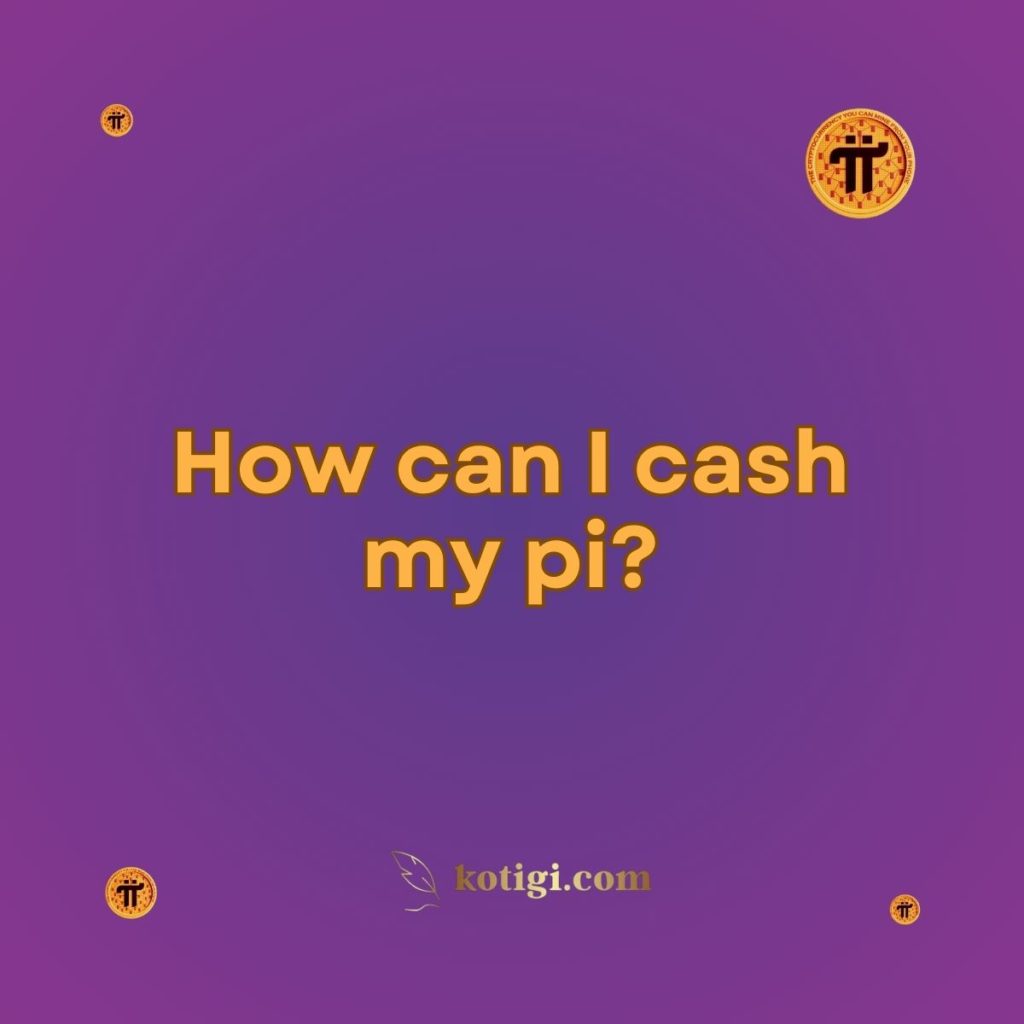
How can I cash my pi?
At this stage, Pi Network has not yet enabled users to cash out their Pi coins. Pi is currently in its enclosed mainnet phase, where it cannot be traded on external exchanges or converted to fiat currency. Once the network transitions to its open mainnet phase and Pi is listed on public exchanges, users may have the opportunity to cash in their Pi. Until then, users can use Pi within the Pi Network’s ecosystem for peer-to-peer transactions or services.
Introduction
With millions of people mining Pi coins through the Pi Network app, the big question on many users’ minds is how and when they can cash out their Pi. Despite the excitement around the potential value of Pi, the ability to convert Pi into money is not yet available. Pi Network is still in its enclosed mainnet phase, which limits the external trade or sale of Pi coins. In this post, we will explore Pi’s journey so far, the steps needed before Pi can be cashed out, and what users can expect in the future.
Understanding Pi Network’s Enclosed Mainnet Phase
What Is the Enclosed Mainnet Phase?
Pi Network is currently in what is known as the “enclosed mainnet phase.” During this phase, users can continue mining Pi coins via the mobile app, but these coins remain locked within the network. This means that Pi coins cannot be transferred to external wallets or traded on public exchanges. The enclosed mainnet allows Pi Network’s developers to build the necessary infrastructure, such as wallets, nodes, and apps, while maintaining security and stability within the ecosystem.
Why Can’t Pi Be Cashed Out Yet?
One of the main reasons Pi cannot be cashed out yet is because it is still not listed on any public cryptocurrency exchanges. The Pi Network team is focused on building a functional, decentralized ecosystem before allowing Pi coins to be traded externally. Once the network transitions to its open mainnet phase and Pi is listed on exchanges, users will have the opportunity to cash out their coins.
For now, the enclosed mainnet serves as a testing ground for the Pi ecosystem, ensuring that the network is secure, scalable, and decentralized before the open mainnet is launched.
What Needs to Happen Before Pi Can Be Cashed Out?
Transition to Open Mainnet
The key event that must occur before Pi can be cashed out is the transition from the enclosed mainnet to the open mainnet phase. The open mainnet phase will allow Pi coins to be transferred to external wallets, enabling users to trade their Pi on public exchanges for fiat currency (such as USD, EUR, etc.) or other cryptocurrencies (such as Bitcoin or Ethereum).
While the Pi Core Team has not provided an exact date for the open mainnet launch, they have emphasized the importance of building a robust ecosystem and ensuring decentralization before making Pi tradable.
Listing on Cryptocurrency Exchanges
Once Pi reaches the open mainnet phase, the next step is getting listed on cryptocurrency exchanges. Major exchanges like Binance, Coinbase, or Kraken would allow users to trade Pi with other digital currencies or cash. However, getting listed on these platforms requires Pi to meet several criteria, such as network security, decentralization, regulatory compliance, and sufficient liquidity.
The Pi team must ensure that Pi meets the standards of major exchanges to facilitate its listing. Once listed, users would be able to cash out their Pi by selling it on these exchanges.
Building a Sustainable Ecosystem
Another important factor before Pi can be cashed out is the development of a sustainable ecosystem. Pi Network is working to create real-world use cases for Pi, such as decentralized applications (dApps), peer-to-peer transactions, and partnerships with merchants. By building an ecosystem that provides actual utility for Pi coins, the network can support the coin’s long-term value and ensure that users can cash out their Pi at a meaningful price.
How Will Users Be Able to Cash Out Pi?
Selling Pi on Exchanges
Once Pi is listed on cryptocurrency exchanges, users will be able to cash out their Pi by selling it on these platforms. The process will be similar to how other cryptocurrencies are traded:
- Create an Account on an Exchange: Users will need to sign up on a cryptocurrency exchange that lists Pi, such as Binance or Coinbase.
- Transfer Pi to the Exchange Wallet: Once the open mainnet is live, users will be able to transfer their mined Pi coins from their Pi Network wallet to their exchange wallet.
- Sell Pi for Fiat or Cryptocurrency: Users can place sell orders to exchange Pi for fiat currencies like USD or EUR, or for other cryptocurrencies such as Bitcoin or Ethereum.
- Withdraw Funds: After selling Pi, users can withdraw their funds to a bank account (for fiat currency) or to an external crypto wallet (for cryptocurrencies).
Using Pi for Goods and Services
An alternative to cashing out Pi directly is to use it as a means of payment for goods and services within the Pi Network ecosystem. The Pi team aims to create an economy where users can spend their Pi coins on products and services, potentially reducing the need to cash out entirely.
Currently, some pioneers are already exchanging Pi for goods and services within the Pi community through peer-to-peer transactions. As the ecosystem grows, more merchants could begin accepting Pi as a legitimate form of payment.
Peer-to-Peer Transactions
Even before Pi is listed on exchanges, users may be able to trade their Pi with other users in the network for goods or services. For instance, someone could sell a product to another Pi user in exchange for a certain amount of Pi coins. This form of peer-to-peer exchange is common in the early stages of cryptocurrency projects and helps establish Pi’s value within its community.
Risks and Challenges in Cashing Out Pi
Market Volatility
One of the biggest risks in cashing out Pi is the potential for market volatility. Like many new cryptocurrencies, Pi could experience significant price fluctuations once it is listed on exchanges. This means that users who rush to sell their Pi may do so at a lower value than anticipated, especially if the market experiences a price correction after Pi’s initial listing.
To mitigate this risk, users should carefully monitor the market and avoid selling during periods of extreme volatility.
Regulatory Hurdles
Regulatory challenges are another factor that could impact the ability to cash out Pi. Cryptocurrencies are subject to varying regulations in different countries, and Pi must comply with these regulations to be listed on exchanges and used as a legitimate form of payment.
While the Pi Network team has implemented a Know Your Customer (KYC) process to ensure regulatory compliance, additional legal requirements could still affect Pi’s ability to be traded or cashed out in certain regions.
Future Potential of Cashing Out Pi
Pi as a Long-Term Investment
While many users are eager to cash out their Pi as soon as it becomes available on exchanges, others may choose to hold onto their Pi coins as a long-term investment. If Pi’s ecosystem continues to grow and more use cases are developed, the value of Pi could increase over time, offering greater rewards for those who hold their coins for the long term.
Like Bitcoin or Ethereum, Pi could see significant price appreciation if its network gains widespread adoption and utility.
Integrating Pi with Traditional Finance
In the long term, Pi could potentially be integrated with traditional financial systems, allowing users to cash out Pi directly into their bank accounts. This would require partnerships with financial institutions and further regulatory approvals, but it is a possibility for Pi’s future as a widely adopted digital currency.
When Will Pi Be Cashable?
Waiting for the Open Mainnet
The short answer to when Pi can be cashed out is that it will depend on the transition to the open mainnet phase. The Pi team is focused on ensuring that the network is fully decentralized, secure, and ready for public trading before allowing users to cash out their coins.
While no official timeline has been provided, users should keep an eye on announcements from the Pi Core Team regarding the open mainnet launch. Once the open mainnet is live, users will finally be able to transfer their Pi coins to external wallets and exchange them for fiat currency or other cryptocurrencies.
Staying Informed
In the meantime, it’s important for users to stay informed about Pi’s progress and any updates from the Pi Core Team. This includes following official Pi channels, joining the community discussions, and understanding the milestones Pi must reach before cashing out becomes possible.
Conclusion
Currently, users cannot cash out their Pi coins due to the network being in its enclosed mainnet phase. However, once Pi transitions to its open mainnet phase and gets listed on cryptocurrency exchanges, users will have the opportunity to trade their Pi for fiat currency or other digital assets. Until then, users can explore peer-to-peer transactions within the Pi ecosystem or consider holding their Pi as a long-term investment.
Cashing out Pi will depend on several factors, including the successful launch of the open mainnet, Pi’s listing on exchanges, and the development of a sustainable ecosystem. While there are risks involved, the future potential of Pi as a digital currency could offer significant rewards for those who stay the course.
Key Takeaways:
- Pi Network is in the enclosed mainnet phase, meaning users cannot currently cash out their Pi coins.
- The open mainnet phase is expected to enable external trading and listing of Pi on cryptocurrency exchanges.
- Users will be able to cash out Pi by selling it on exchanges or using it for goods and services within the Pi ecosystem.
- Market volatility and regulatory challenges could impact the ability to cash out Pi once it becomes tradable.
- Pi’s long-term potential as a digital currency could provide significant rewards for those who hold their Pi coins.





